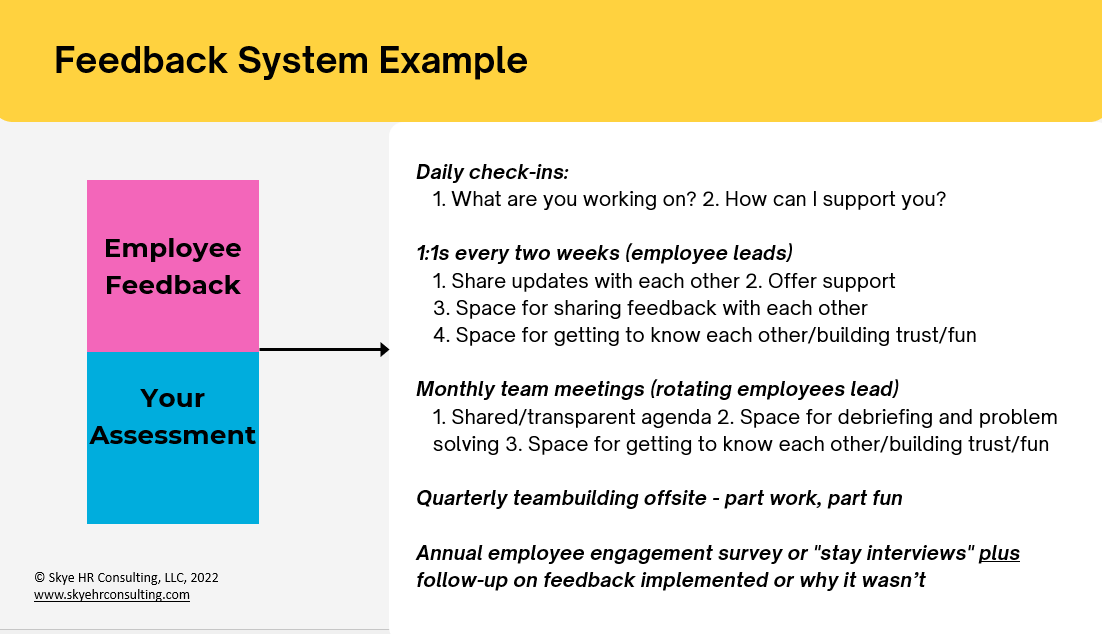How to Create Systems for Feedback
What is the most challenging aspect of supervising employees?
For me, it’s giving feedback to and receiving feedback from employees I supervise. And, empowering employees on the team to give meaningful feedback to each other.
Over the past several months, I've facilitated leadership training in nonprofits, local governments, and purpose-driven organizations.
(*You can check out the list of customizable training available to your organization here.)
The most frequent questions from leaders have been...
One of my employees is struggling, how do I help them succeed?
I need to set expectations with an employee I supervise, how do I do that?
A couple team members I supervise are not getting along, how do I set expectations and hold them accountable around teamwork?
How do I ask for feedback from my team so that I'm developing as a leader?
What I find when we dig deeper into these questions is sometimes the leader doesn't have much of a "system" for giving/receiving feedback, so feedback tends to be infrequent, unstructured, and in the worst cases handled randomly. So, the leader feels uncomfortable and hesitant about giving or asking for the feedback.
Without a system for feedback, when issues like the bulleted list above arise, there isn't a clear, practiced framework or structure to use. Creating systems for feedback (aka systemic feedback, feedback strategy, continuous feedback, feedback loops, etc.) is a great way to make feedback with and among your team more frequent, effective, and comfortable!
Feedback systems help teams build trust, engagement, and overall work better together.
What are systems for feedback?
Systems for feedback are repeated, planned opportunities for giving and receiving feedback. Each team's system for feedback looks different and there are nuances based on individual trust-levels, work locations, job types, team size, etc. Systemic feedback can occur in many ways.
Some ideas for systemic feedback include...
Annual employee feedback survey and debriefing session
Space for feedback built into monthly team meeting agendas (feedback can be shared as a group, 1:1, or smaller breakout groups)
Weekly 1:1 check-ins with employees that include consistent feedback-invoking questions, such as "what can I start or stop doing to better support you?"
One of the most important things to remember as supervisors is that we need to set up systems that allow feedback to flow multiple ways (to/from the employees we supervisor, among our teams, among our peers, with our own supervisor, etc.). We need consistent ways in which we both ask for and share feedback. We also need to help our teams build trusting relationships with each other (and practiced feedback skills) so they can effectively share feedback with each other.
When team’s feedback system is rooted in trust, equity, and inclusion, feedback is much more consistent, inclusive, and effective.
Why is having a "system" for feedback important?
When opportunities to give and receive feedback are random, unstructured, or infrequent, it makes it harder to give or receive the feedback in the first place. When there's a system in place, we tend to practice a lot more, build our skill in giving/receiving feedback, and get better at it.
When a supervisor, employee, and their team members deeply listens to and applies feedback, it creates....
Employee engagement
Trusting relationships
More cohesive and inclusive teams
Creative problem solving
Generative conflict (yes, conflict can be a good thing- conflict often generates ideas and solutions!)
How to set up your team's feedback system
First start by....you guessed it, asking your team for feedback on how to set up your feedback system!
One idea would be to use the information in this article to provide context and then perhaps give them a couple of examples of what systemic feedback could look like for your team. Ask your team....
How frequently do we currently engage in opportunities to give and receive feedback with each other?
How frequently do we WANT to engage in opportunities to give and receive feedback with each other?
After looking at a couple of examples, are there any of these feedback opportunities you think we should try?
What other thoughts/ideas do you have?
How comfortable do you feel with giving and receiving feedback with each other? (The answer to this question may vary individually. If the answer is something along the lines of "not very," it's likely time to engage in individual coaching, team training, or trust building/teambuilding activities.)
Here is one example of a system of feedback a team I work with uses (remember- not everyone's systems look the same! Your list may look longer, shorter, or contain different ideas altogether):
Can you change your feedback system once it's in place?
Yes! Nothing is set in stone. If you set up a system for feedback and it doesn't work or the team would like to try something else, the beauty is you can collaboratively change things.
How comfortable are you and your team giving and sharing feedback with each other?
If you or your employees don't feel comfortable, a system for feedback is a great place to start in building more frequent opportunities and practicing so that you feel more comfortable.
Also, consider these resources for building skill and comfort in giving/receiving feedback:
Facilitated training with a neutral instructor
Individual coaching
Role playing for practice giving/receiving feedback
Using a framework for feedback, such as from the book "Non-Violent Communication"
Other resources include: "Thanks for the Feedback," "Radical Candor" Book and Blog, and "Crucial Conversations"
Do you need support…Setting up your system for feedback? Or, giving feedback on a specific issue? Or processing feedback you've received?
Schedule/pay-as-you-go HR consulting is available to you!
Schedule your HR Strategy Session to receive an up to 60-minute HR consulting or leadership coaching session focused on quickly answering your questions and solving your specific pressing HR/leadership challenges. You will receive a customized, one-time session that gives you expert guidance and a clear plan of action to resolve your immediate HR challenges.

